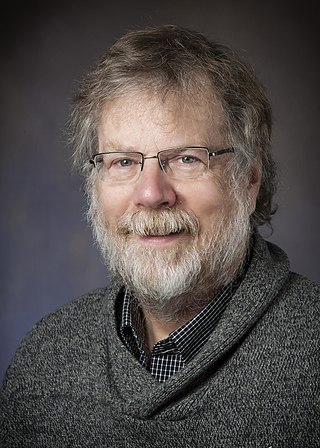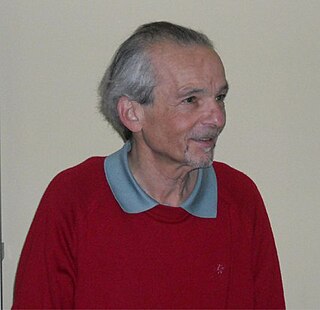In physics, statistical mechanics is a mathematical framework that applies statistical methods and probability theory to large assemblies of microscopic entities. It does not assume or postulate any natural laws, but explains the macroscopic behavior of nature from the behavior of such ensembles.

A timeline of events in the history of thermodynamics.
The fluctuation theorem (FT), which originated from statistical mechanics, deals with the relative probability that the entropy of a system which is currently away from thermodynamic equilibrium will increase or decrease over a given amount of time. While the second law of thermodynamics predicts that the entropy of an isolated system should tend to increase until it reaches equilibrium, it became apparent after the discovery of statistical mechanics that the second law is only a statistical one, suggesting that there should always be some nonzero probability that the entropy of an isolated system might spontaneously decrease; the fluctuation theorem precisely quantifies this probability.
The Jarzynski equality (JE) is an equation in statistical mechanics that relates free energy differences between two states and the irreversible work along an ensemble of trajectories joining the same states. It is named after the physicist Christopher Jarzynski who derived it in 1996. Fundamentally, the Jarzynski equality points to the fact that the fluctuations in the work satisfy certain constraints separately from the average value of the work that occurs in some process.

Richard Chace Tolman was an American mathematical physicist and physical chemist who made many contributions to statistical mechanics. He also made important contributions to theoretical cosmology in the years soon after Einstein's discovery of general relativity. He was a professor of physical chemistry and mathematical physics at the California Institute of Technology (Caltech).
The Green–Kubo relations give the exact mathematical expression for a transport coefficients in terms of the integral of the equilibrium time correlation function of the time derivative of a corresponding microscopic variable :
Harry L. Swinney is an American physicist noted for his contributions to the field of nonlinear dynamics.
Debra Bernhardt is an Australian theoretical chemist. She is best known for her contributions towards understanding the fluctuation theorem. This theorem shows the second law of thermodynamics and the zeroth law of thermodynamics can be derived mathematically rather than postulated as laws of nature.
The nonequilibrium partition identity (NPI) is a remarkably simple and elegant consequence of the fluctuation theorem previously known as the Kawasaki identity:
Harry Eugene Stanley is an American physicist and University Professor at Boston University. He has made seminal contributions to statistical physics and is one of the pioneers of interdisciplinary science. His current research focuses on understanding the anomalous behavior of liquid water, but he had made fundamental contributions to complex systems, such as quantifying correlations among the constituents of the Alzheimer brain, and quantifying fluctuations in noncoding and coding DNA sequences, interbeat intervals of the healthy and diseased heart. He is one of the founding fathers of econophysics.

David Matthew Ceperley is a theoretical physicist in the physics department at the University of Illinois Urbana-Champaign or UIUC. He is a world expert in the area of Quantum Monte Carlo computations, a method of calculation that is generally recognised to provide accurate quantitative results for many-body problems described by quantum mechanics.
Peter Hänggi is a theoretical physicist from Switzerland, Professor of Theoretical Physics at the University of Augsburg. He is best known for his original works on Brownian motion and the Brownian motor concept, stochastic resonance and dissipative systems. Other topics include, driven quantum tunneling, such as the discovery of coherent destruction of tunneling (CDT), phononics, relativistic statistical mechanics and the foundations of classical and quantum thermodynamics.

David R. Nelson is an American physicist, and Arthur K. Solomon Professor of Biophysics, at Harvard University.
Gavin Earl Crooks is known for his work on non-equilibrium thermodynamics and statistical mechanics. He discovered the Crooks fluctuation theorem, a general statement about the free energy difference between the initial and final states of a non-equilibrium transformation.
Ezechiel Godert David "Eddie" Cohen was a Dutch–American physicist and Professor Emeritus at The Rockefeller University. He is widely recognised for his contributions to statistical physics. In 2004 Cohen was awarded the Boltzmann Medal, jointly with Prof. H. Eugene Stanley. Cohen's citation read "For his fundamental contributions to nonequilibrium statistical mechanics, including the development of a theory of transport phenomena in dense gases, and the characterization of measures and fluctuations in nonequilibrium stationary states."

Bernard Howard Lavenda is a retired professor of chemical physics at the University of Camerino and expert on irreversible thermodynamics. He has contributed to many areas of physics, including that of Brownian motion, and in the establishment of the statistical basis of thermodynamics, and non-Euclidean geometrical theories of relativity. He was the scientific coordinator of the "European Thermodynamics Network" in the European Commission Program of Human Capital and Mobility. He was also a proponent for the establishment of, and scientific director of, a National (Italian) Centre for Thermodynamics, and has acted as scientific consultant to companies such as the ENI Group, where he helped to found TEMA, a consulting firm for SNAM Progetti, ENEA, and the Solar Energy Research Institute in Golden, Colorado. He has had over 130 scientific papers published in international journals, some critical of the new fashions and modes in theoretical physics.

Michael Elmhirst Cates is a British physicist. He is the 19th Lucasian Professor of Mathematics at the University of Cambridge and has held this position since 1 July 2015. He was previously Professor of Natural Philosophy at the University of Edinburgh, and has held a Royal Society Research Professorship since 2007.
Stochastic thermodynamics is an emergent field of research in statistical mechanics that uses stochastic variables to better understand the non-equilibrium dynamics present in many microscopic systems such as colloidal particles, biopolymers, enzymes, and molecular motors.
Christopher Jarzynski is an American physicist and distinguished university professor at University of Maryland's department of chemistry and biochemistry, department of physics, and institute for physical science and technology, and fellow of the National Academy of Sciences. He is known for his contributions to non-equilibrium thermodynamics and statistical mechanics, for which he was awarded the 2019 Lars Onsager Prize. In 1997, he derived the now famous Jarzynski equality, confirmation of which was cited by the Nobel Committee for Physics as an application of one of the winning inventions of the 2018 Nobel Prize in physics—optical tweezers.
Katja Lindenberg is an Ecuadorian-American theoretical chemical physicist whose research concerns statistical mechanics, stochastic processes, non-equilibrium thermodynamics, and quantum thermodynamics. She is Distinguished Professor of Chemistry and Chancellor's Associates Endowed Chair Emeritus at the University of California, San Diego.






